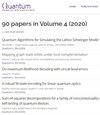Characterizing maximally many-body entangled fermionic states by using $M$-body density matrix
IF 5.1
2区 物理与天体物理
Q1 PHYSICS, MULTIDISCIPLINARY
引用次数: 0
Abstract
Fermionic Hamiltonians play a critical role in quantum chemistry, one of the most promising use cases for near-term quantum computers. However, since encoding nonlocal fermionic statistics using conventional qubits results in significant computational overhead, fermionic quantum hardware, such as fermion atom arrays, were proposed as a more efficient platform. In this context, we here study the many-body entanglement structure of fermionic $N$-particle states by concentrating on $M$-body reduced density matrices (DMs) across various bipartitions in Fock space. The von Neumann entropy of the reduced DM is a basis independent entanglement measure which generalizes the traditional quantum chemistry concept of the one-particle DM entanglement, which characterizes how a single fermion is entangled with the rest. We carefully examine upper bounds on the $M$-body entanglement, which are analogous to the volume law of conventional entanglement measures. To this end we establish a connection between $M$-body reduced DM and the mathematical structure of hypergraphs. Specifically, we show that a special class of hypergraphs, known as $t$-designs, corresponds to maximally entangled fermionic states. Finally, we explore fermionic many-body entanglement in random states. We semianalytically demonstrate that the distribution of reduced DMs associated with random fermionic states corresponds to the trace-fixed Wishart-Laguerre random matrix ensemble. In the limit of large single-particle dimension $D$ and a non-zero filling fraction, random states asymptotically become absolutely maximally entangled.用M体密度矩阵刻画最大多体纠缠费米子态
费米子哈密顿子在量子化学中起着至关重要的作用,量子化学是近期量子计算机最有前途的用例之一。然而,由于使用传统量子比特编码非局部费米子统计会导致显著的计算开销,因此费米子量子硬件,如费米子原子阵列,被认为是一个更有效的平台。在此背景下,我们研究了费米子N粒子态的多体纠缠结构,重点研究了Fock空间中不同双分域的M体约化密度矩阵。约简费米子的冯·诺伊曼熵是一种与基无关的纠缠度量,它概括了传统的单粒子费米子纠缠的量子化学概念,表征了单个费米子如何与其他费米子纠缠。我们仔细研究了M -体纠缠的上界,它类似于传统纠缠测度的体积定律。为此,我们建立了$M$-体约简DM与超图数学结构之间的联系。具体地说,我们证明了一类特殊的超图,称为$t$-设计,对应于最大纠缠费米子态。最后,我们探讨了随机态的费米子多体纠缠。我们半解析地证明了与随机费米子态相关的约简dm的分布对应于迹固定的Wishart-Laguerre随机矩阵系综。在大单粒子维D和非零填充分数的极限下,随机态渐近地成为绝对最大纠缠态。
本文章由计算机程序翻译,如有差异,请以英文原文为准。
求助全文
约1分钟内获得全文
求助全文
来源期刊

Quantum
Physics and Astronomy-Physics and Astronomy (miscellaneous)
CiteScore
9.20
自引率
10.90%
发文量
241
审稿时长
16 weeks
期刊介绍:
Quantum is an open-access peer-reviewed journal for quantum science and related fields. Quantum is non-profit and community-run: an effort by researchers and for researchers to make science more open and publishing more transparent and efficient.
 求助内容:
求助内容: 应助结果提醒方式:
应助结果提醒方式:


